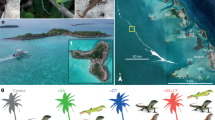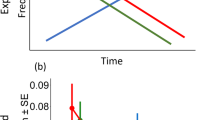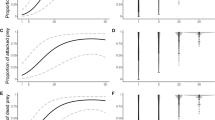Abstract
There has been considerable research on both top-down effects1,2 and on disturbances3,4,5 in ecological communities; however, the interaction between the two, when the disturbance is catastrophic, has rarely been examined6. Predators may increase the probability of prey extinction resulting from a catastrophic disturbance both by reducing prey population size7,8 and by changing ecological traits of prey individuals such as habitat characteristics8,9 in a way that increases the vulnerability of prey species to extinction. We show that a major hurricane in the Bahamas led to the extinction of lizard populations on most islands onto which a predator had been experimentally introduced, whereas no populations became extinct on control islands. Before the hurricane, the predator had reduced prey populations to about half of those on control islands. Two months after the hurricane, we found only recently hatched individuals—apparently lizards survived the inundating storm surge only as eggs. On predator-introduction islands, those hatchling populations were a smaller fraction of pre-hurricane populations than on control islands. Egg survival allowed rapid recovery of prey populations to pre-hurricane levels on all control islands but on only a third of predator-introduction islands—the other two-thirds lost their prey populations. Thus climatic disturbance compounded by predation brought prey populations to extinction.
This is a preview of subscription content, access via your institution
Access options
Subscribe to this journal
Receive 51 print issues and online access
$199.00 per year
only $3.90 per issue
Buy this article
- Purchase on Springer Link
- Instant access to full article PDF
Prices may be subject to local taxes which are calculated during checkout



Similar content being viewed by others
References
Pace, M. L., Cole, J. J., Carpenter, S. R. & Kitchell, J. F. Trophic cascades revealed in diverse ecosystems. Trends Ecol. Evol. 14, 483–488 (1999).
Schmitz, O. J., Hamback, P. A. & Beckerman, A. P. Trophic cascades in terrestrial systems: a review of the effects of carnivore removals on plants. Am. Nat. 155, 141–153 (2000).
Sousa, W. P. The role of disturbance in natural communities. Annu. Rev. Ecol. Syst. 15, 353–392 (1984).
Pickett, S. T. A. & White, P. S. The Ecology of Natural Disturbance and Patch Dynamics (Academic, New York, 1985).
Dunson, W. A. & Travis, J. The role of abiotic factors in community organization. Am. Nat. 101, 97–107 (1991).
Power, M. E., Parker, M. S. & Wootton, J. T. in Food Webs (eds Polis, G. A. & Winemiller, K. O.) 286–297 (Chapman and Hall, London/New York, 1996).
Sih, A., Crowley, P., McPeek, M., Petranka, J. & Strohmeirer, K. Predation, competition, and prey communities: a review of field experiments. Annu. Rev. Ecol. Syst. 16, 269–311 (1985).
Abrams, P. A. Implications of dynamically variable traits for identifying, classifying, and measuring indirect effects in ecological communities. Am. Nat. 146, 112–134 (1996).
Schmitz, O. J., Beckerman, A. P. & O'Brien, K. M. Behaviourally-mediated trophic cascades: the effects of predation risk on food web interactions. Ecology 78, 1388–1399 (1997).
Schoener, T. W., Slade, J. B. & Stinson, C. H. Diet and sexual dimorphism in the very catholic lizard genus Leiocephalus of the Bahamas. Oecologia 53, 160–169 (1982).
Schoener, T. W., Spiller, D. A. & Losos, J. B. Predation upon a devastating predator: can the latter's food-web effects be reversed? Ecol. Monogr. (submitted).
Gerber, S. P. & Echternacht, A. C. Evidence for asymmetrical intraguild predation between native and introduced Anolis lizards. Oecologia 124, 599–607 (2000).
Andrewartha, H. G. & Birch, L. C. Distribution and Abundance of Animals (Univ. Chicago Press, Chicago, 1954).
Menge, B. A. & Sutherland, J. P. Species diversity gradients: synthesis of the role of predation, competition and temporal heterogeneity. Am. Nat. 110, 351–369 (1976).
Schoener, T. W. in Community and Evolutionary Ecology of North American Stream Fishes (eds Matthews, W. J. & Heins, D. C.) 8–16 (Univ. Oklahoma Press, Norman, 1987).
Wiens, J. A. On competition and variable environments. Am. Sci. 65, 590–597 (1977).
Diamond, J. & Case, T. J. Community Ecology (Harper & Row, New York, 1986).
Evans, E. W. Influence of weather on predator/prey relations: stinkbugs and tent caterpillars. J. NY Entomol. Soc. 90, 241–246 (1982).
Holt, R. & Lawton, J. H. The ecological consequences of shared natural enemies. Annu. Rev. Ecol. Syst. 25, 495–520 (1994).
Schoener, T. W. & Spiller, D. A. Devastation of prey diversity by experimentally introduced predators in the field. Nature 381, 691–694 (1996).
Spiller, D. A., Losos, J. B. & Schoener, T. W. Impact of a catastrophic hurricane on island populations. Science 281, 695–697 (1998).
Ackerman, J. New eyes on the ocean. Nat. Geogr. Mag. Oct. 86–114 (2000).
Kareiva, P. M., Kingsolver, J. G. & Huey, R. B. (eds) Biotic Interactions and Global Change (Sinauer, Sunderland, Massachusetts, 1993).
Schwartz, A. & Henderson, R. W. Amphibians and Reptiles of the West Indies 424 (Univ. Florida Press, Gainesville, 1991).
Schoener, T. W. Presence and absence of habitat shift in some widespread lizard species. Ecol. Monogr. 45, 233–258 (1975).
Schoener, T. W. The Anolis lizards of Bimini: resource partitioning in a complex fauna. Ecology 49, 704–726 (1968).
Heckel, D. G. & Roughgarden, J. A technique for estimating the size of lizard populations. Ecology 60, 966–975 (1979).
Fienberg, S. E. The multiple-recapture census. Biometrika 45, 591–603 (1972).
Siegel, S. & Castellan, N. J. Jr Nonparametric Statistics for the Behavioral Sciences 128–137 (McGraw-Hill, New York, 1988).
Acknowledgements
We thank the NSF for support.
Author information
Authors and Affiliations
Corresponding author
Rights and permissions
About this article
Cite this article
Schoener, T., Spiller, D. & Losos, J. Predators increase the risk of catastrophic extinction of prey populations. Nature 412, 183–186 (2001). https://doi.org/10.1038/35084071
Received:
Accepted:
Issue Date:
DOI: https://doi.org/10.1038/35084071
This article is cited by
-
Shorebirds-driven trophic cascade helps restore coastal wetland multifunctionality
Nature Communications (2023)
-
Evolutionary rescue can prevent rate-induced tipping
Theoretical Ecology (2022)
-
Transmission of a novel predatory behaviour is not restricted to kin
Biological Invasions (2021)
-
Predator-induced collapse of niche structure and species coexistence
Nature (2019)
-
Mortal combat between ants and caterpillars: an ominous threat to the endangered Schaus swallowtail butterfly (Heraclides aristodemus ponceanus) in the Florida Keys, USA
Journal of Insect Conservation (2017)
Comments
By submitting a comment you agree to abide by our Terms and Community Guidelines. If you find something abusive or that does not comply with our terms or guidelines please flag it as inappropriate.



